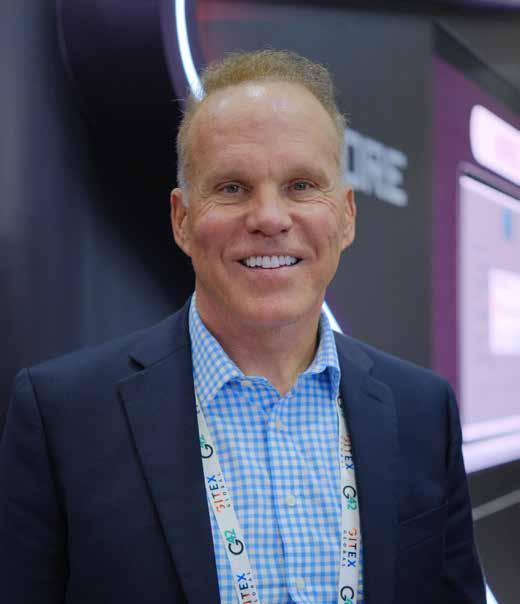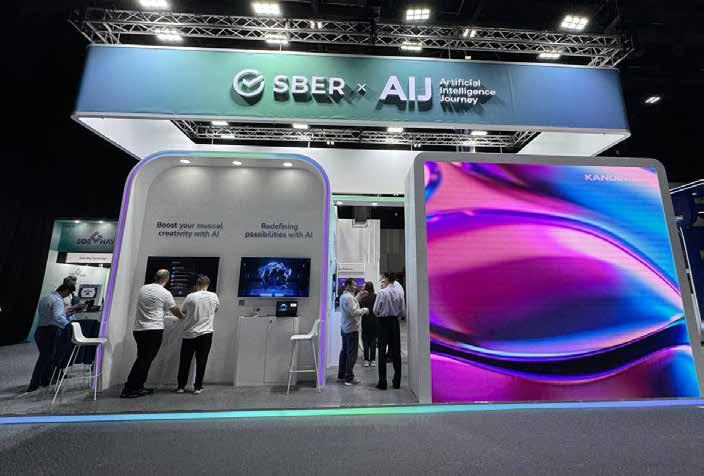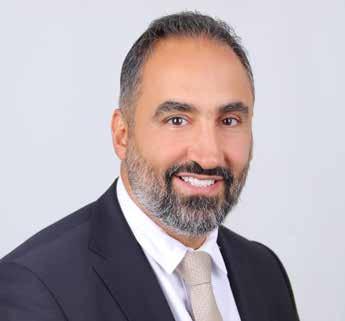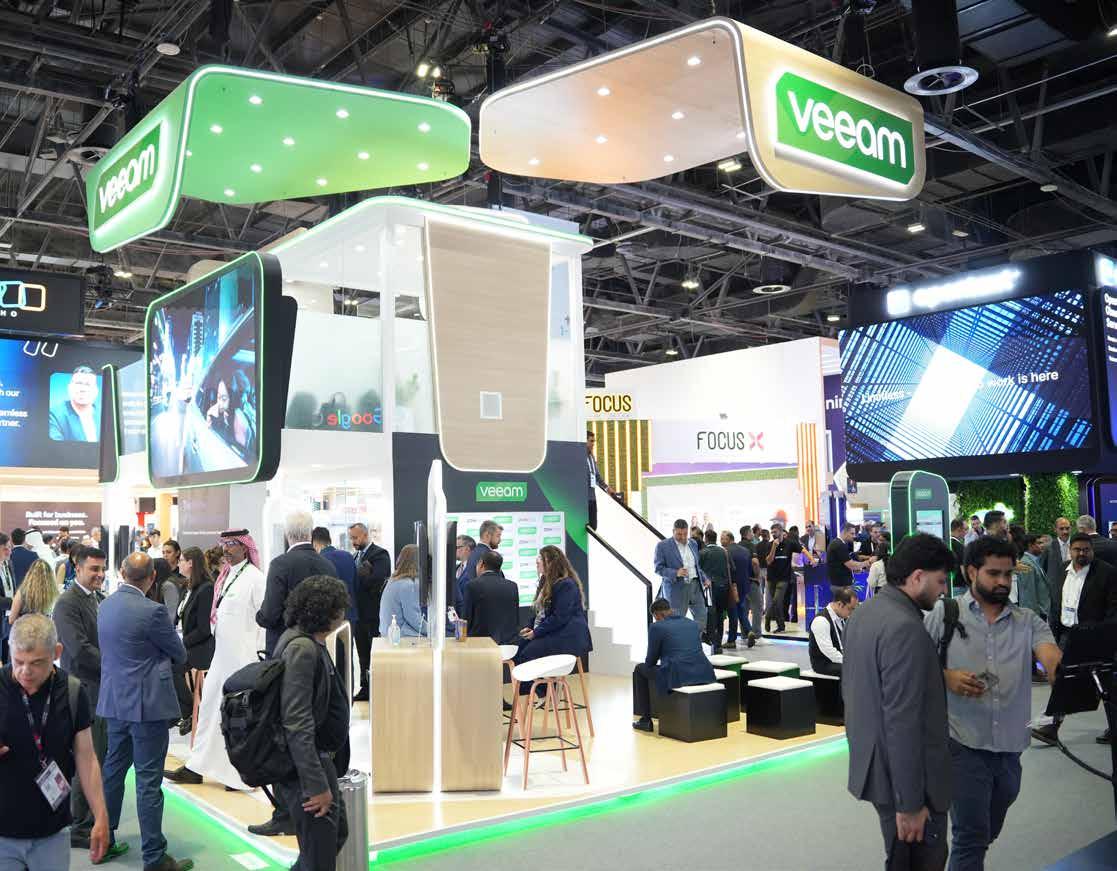










VeronicaMartincaughtupwithAnasNaim,ManagingDirector-MET atOrangeBusiness,duringGITEX2025todiscussLiveIntelligence’s launch,howOrangeBusinessisaddressingAI’schallengeswhile maximisingitspotentialfortheircustomersandhowtheyare strengtheningtheirsolutionstoensureresilienceandtrust.

Veronica Martin spoke to Neil Colquhoun, President at Epson METACW Asia, during GITEX 2025 about how Epson is evolving enterprise solutions to support digital transformation, hybrid learning, and eco-efficient printing across government, corporate, and education sectors.



At GITEX 2025, Jithin Varghese, Head of the High-Performance Business Unit, Middle East and Emerging Africa, VAD Technologies, speaks about the importance of delivering
Many companies are unveiling new solutions and products at GITEX 2025 — what is the key innovation or launch you’re most excited to showcase this year, and why is it relevant for the region? The launch we’re announcing here AI
How is Epson evolving its enterprise solutions to support digital transformation across government and corporate sectors?
As you know, we’ve been involved in enterprise for a long time. I’d say it’s ongoing, and specifically at the moment, we’re expanding our range of enterprise printing to align with digital transformation. Our printers, of course, print - but they also scan, include digitisation software, and interact with external systems.
Effectively, what we do is work closely

Can you tell us about your role at VAD Technologies and the approaches you’ve pioneered for key vendors and partners?
“My responsibilities focus on building and growing our business around Pure Storage and ExaGrid, which
How best to empower talent and foster innovation in a fastevolving landscape pre-occupied with AI-driven transformation and scalable tech? At GITEX 2025, Mark Forker spoke to Feras Al Majed, General Manager - Human Resources & Communications, GBM, to explore how the company is shaping ‘A More Intelligent Future’ - a future where inclusiveness and transparency are paramount.
What are GBM’s key themes or innovations being showcased at GITEX 2025?
The theme we’re here to demonstrate is ‘Exploring a More Intelligent Future.’ What does that mean? It’s
not just about enabling companies with the latest innovations in data, AI, hybrid cloud, security, or automation - it’s also about empowering the talent behind these technologies. Our goal is to help people fully leverage these tools to drive progress and strengthen the economies we serve. Take AI, for example.
At GITEX 2025, leading tech entrepreneur Ron Heinz, Founder and Managing Partner, Oquirrh Ventures, spoke to Veronica Martin about his views on the Middle East as an emerging destination for tech investments, and the potential impact of his investment in Seclore as a change-maker for the regional tech ecosystem.
How do you view the Middle East, particularly the UAE, as an emerging destination for tech investments?
First of all, we’ve made a couple of investments. I run a private equity firm that invests in software companies and Seclore. One Cosmos is another company in our portfolio here. I think the business in the Middle East is really in hypergrowth. Our company, Seclore in particular, generates over 50% of its revenue from this region alone. I’ve never seen this type of growth before - and I’ve been doing this for a long time.
As the region continues to adopt information technology security practices of all kinds, and becomes increasingly compliant with new emerging government mandates and regulations around technology, the potential here is huge. It’s a very exciting moment and I think it’s just the beginning.
What role do you think events like GITEX Global 2025 play in connecting investors with high-potential startups?
GITEX is an excellent platform for connecting
with customers, partners, and the broader tech ecosystem. There’s plenty of time to explore, and the ecosystem spans both well-established companies and emerging players like Seclore and One Cosmos. Beyond that, there’s a vast network of smaller companies - getting to know them and arranging meetings in advance is highly worthwhile given the sheer number of participants. Maximising opportunities to meet these companies while we’re here is always extremely valuable from a scheduling and
relationship-building perspective.
As an early investor in Seclore, which has a strong presence in this region, how do you see such investments shaping the regional tech ecosystem?
If you look at the growth patterns in the software market years ago, the typical approach was to start by investing in the U.S., then expand to Europe. Today, I think moving into the region early is extremely valuable because the growth opportunities are so exciting. For example,


*Heat scale comparison for illustration purposes only. For more information please visit: www.epson.com/eme
4 CONTINUED
is Live Intelligence, a generative AI platform developed in collaboration with our partners, LightOn & Edarat Group, and powered by Nvidia for high-performance computing. This is a major milestone for us, as it marks the first time Live Intelligence will be available locally in the GCC. While based in the UAE, it will serve the entire GCC region, offering full data sovereignty, governance, and comprehensive security measures.
What makes it particularly exciting is that companies can customise and personalise the platform. The data they use for training stays secure, making generative AI applications safer, more reliable, and tailored for business use.
With the UAE’s recent focus on national AI infrastructure projects, how is your company contributing to building or enabling this ecosystem?
We’re a professional services and solutions
Our approach starts with understanding the specific requirements and business challenges our clients are trying to address”.
provider, helping customers define, design, and implement their AI journeys. Our role starts with identifying key business requirements and opportunities, then guiding clients through building the right data platforms and architectures—ensuring they are secure, reliable, scalable, and aligned with business goals.
A major focus for us is creating a unified data architecture that supports data governance and interoperability across systems and services. This foundation is critical to helping organisations maximise the value of their data.
As a solutions provider, we also deliver tailored AI solutions based on each customer’s desired business outcomes. Whether working with public or private sector organisations,
4 CONTINUED FROM PAGE 1
we invested in SLO three years ago when the company had around $11 million in annual recurring revenue (ARR). This year, that number is projected to reach about $40 million, with a significant portion of that growth coming from this region. We plan to continue investing here and supporting that growth. While it’s hard to predict exactly how large the market can get, based on what I’ve seen so far, the potential is very substantial.
What are your impressions of the UAE’s transformation into a global technology and innovation hub?
Yeah, it’s quite remarkable. On my flight
William O’Neill
our goal is to translate requirements into measurable results and address real business challenges through AI and data-driven innovation.
AI presents huge opportunities but also real challenges — from data quality and governance to scalability. How is your organisation addressing these challenges while maximising AI’s potential for your customers?
AI is definitely a major buzzword right now — it’s broad, and the real challenge for organisations is figuring out how to practically implement it within their operations. Our approach always starts with understanding the specific requirements and business challenges our clients are trying to address. From there, we architect and
implement AI solutions that directly align with those objectives.
A few key priorities guide our work. First and foremost is strong data governance — because AI is only as effective as the data behind it. We focus on ensuring security, access management, and data quality compliance, which are critical in today’s environment.
We also invest heavily in workforce upskilling. To deliver real expertise to our clients, we need to maintain that expertise internally. So, we continuously train our teams to stay ahead of emerging AI capabilities and bridge the skills gap needed for effective AI adoption.
Finally, we place a strong emphasis on responsible AI practices — ensuring that every implementation is ethical, transparent, and compliant with regulatory standards. In today’s world, as AI becomes more deeply embedded in everyday processes, that responsibility is absolutely essential.
The cybersecurity threat landscape continues to evolve in parallel with advances in AI and

Ron Heinz
cloud adoption. How are you strengthening your solutions to ensure resilience and trust in this new digital era?
Security is deeply embedded across our entire portfolio — from cloud to AI and every platform in between. It’s absolutely central to everything we do.
Our approach is built around four key pillars. The first is governance and compliance, helping our customers design and implement their own AI frameworks with the right oversight and regulatory alignment. The second is AI risk management, ensuring that potential vulnerabilities are identified and mitigated early. The third focuses on AI offensive testing and hardening, strengthening systems to ensure they’re resilient and secure.
Finally, we leverage AI-powered managed security services to provide continuous protection and monitoring across all environments. In short, security isn’t a separate layer for us — it’s woven into every solution we deliver.
Are you announcing any new partnerships or collaborations
during the event, and how do these align with your growth and innovation strategy?
We’re very excited to announce the launch of Live Intelligence, which we officially unveiled today. This is a major milestone for us and definitely something we want to highlight. What makes it so significant is that we’re localising a globally trending generative AI solution — bringing it closer to enterprises in the region while ensuring it meets the highest standards of security, stability, and compliance.
We’ve also announced a strategic partnership with Custodian, one of our key collaborators here at the stand. They’re deeply involved in the data space, and this partnership strengthens our ability to deliver secure, endto-end AI and data solutions.
In addition, Expand Retail, a leading player in the retail industry, are leveraging our Live Objects IoT Connect platform to build their own intelligence layer and better serve the retail market. This collaboration really demonstrates how our technologies can enable innovation across different
We plan to continue investing here and supporting the region’s growth… Based on what I’ve seen so far, the potential is very substantial.”
here last night, I was talking to a KLM flight attendant who’s been flying to Dubai for 30 years. She mentioned that over that time, the city just kept adding buildings, continually

growing and building infrastructure - it’s phenomenal. I also love that Dubai is easy to get to and that people enjoy coming here. You can really see that reflected in the show here today - it’s a testament to the comfort level and the city’s role as a true technology hub. From that perspective, it’s fantastic to be here, and we plan to continue investing in the region. We have high expectations for growth, and we’re encouraging more of our portfolio companies - currently nine in our growth portfolio - to establish a presence in the Middle East sooner rather than later. Where in the past it might have been the fourth or fifth market to enter, now we’re putting it right at the top in terms of timing and investment priority.
4
with a customer - for example, a government entity - to understand their specific needs and then develop creative solutions. This can include everything from printing to scanning technology and addressing questions about digitisation and the so-called paperless office. Even in highly modern economies like the UAE, there’s still a need for white signatures, so printing remains essential.
From Epson’s perspective, our goal is to print in an economical and environmentally friendly way. Our technology is different from most of the industry. While many printers use laser technology, ours is based on Epson’s proprietary Micro Piezo inkjet technology, which is heat-free. What does that mean? It means we can print using up to 90% less power consumption. Multiply that across a city, a country, or even a region, and the savings are significant.
We achieve this because there’s no heat inside the printer. So, we’re not just answering the technology question; you’re also getting compact, precise engineering designed with ecological and economic reasons in mind.
What new workplace technologies or ecoefficient printing solutions are you showcasing at GITEX 2025 for enterprise clients?
We have the latest range of high-speed printers for centralised document printing - that means up to 100 pages per minute - but we also offer a range of smaller
4 CONTINUED FROM PAGE 1 VAD Technologies...
are key contributors to the company’s success. I work closely with our vendors and partners to deliver highperformance, datadriven solutions that help customers get the most out of their technology investments.”
What is VAD Technologies’ primary focus here at GITEX?

desktop printers. We understand that some companies prefer not to have centralised printing for confidentiality reasons. For example, a management suite might require localised printing. So, we provide solutions ranging from the smallest desktop printers to the largest enterprise machines.
Our inkjet technology is heat-free, which comes with a big advantage: fast first-page output. With a laser printer, you often have to wait for the machine to warm up, sometimes for hours. With our heat-free technology, you simply press print, and the page comes out almost instantly. That’s extremely valuable because time is moneyand the best technology today is technology that saves time. Think of Amazon Prime, or Netflix without ads. It’s all about speed and convenience. We listen carefully to our customers: they want compact, efficient, lowcost printing that’s also fast. That’s exactly what this new range delivers - the fastest first-page output on the market. Beyond printing, we also provide advanced scanning technology and solutions for commercial printing. The needs differ depending
on the enterprise: a typical financial district office may only require centralised and localised printing. But other industries, like fashion or merchandising, might need sublimation printing - that means printing directly onto mugs, t-shirts, or other products. We offer technology to support that as well, covering the full spectrum of enterprise printing needs.
How is Epson helping educational institutions enhance hybrid learning environments through projection and collaboration tools? Education is one of our most significant markets, and we’ve been No.1 in projectors globally since 2001. We have a number of large education agreements across the Middle East, Africa, Turkey, and Central West Asia, which is our region. The reason schools choose projectors over flat panels is primarily size. Flat panels are popular at home, so people often wonder why they wouldn’t work in the classroom. The challenge is visibility: from the back of the classroom, a flat panel just doesn’t deliver. Our projectors, however, can easily reach 120 to 150 inches (almost double the size of most
flat panels) providing much more impact and engagement in learning. We also provide printing solutions for schools. While this may not be as common in the GCC, in many of our regional markets, educators don’t want children to stare at tablets all day. There’s growing concern about screen time, yet classrooms often assume digital is the default. A hybrid approach works best: our printing technology allows teachers to print assignments or homework for students to complete offline. In some countries, schools are moving away from annual textbooks - lessons are partially digitised, but homework is printed, completed, and returned for marking.
While the UAE may be more fully digitised, many of our markets are still emerging, so our solutions help bridge the gap between digital and traditional learning methods.
With governments driving paperless and smarter office initiatives, how is Epson adapting its product strategy to stay relevant? I think we need to view this from a broader perspective. Living in the UAE, we’re in an incredibly digitised and well-connected environment. For example, the UAE Smart Pass is extremely useful, and I was even using it to pay for parking yesterday. The world outside the UAE isn’t necessarily as advanced, though. There’s still a long way to go. For example, Epson Middle East was only recently incorporated as a Dubai-based company last year, and a lot of our processes still relied on wet signatures. While
With Epson, when printing is needed, it’s productive, lowmaintenance, cost-efficient, and reliable - all designed to make life easier for the customer.”
we use solutions like DocuSign, there’s still a need for both digital and physical workflows.
We’re able to support digitisation through our scanning technology and visual solutions; helping customers visualise documents without needing a physical copy. Nonetheless, printing remains necessary in many contexts. From our perspective, we don’t need the print market to grow; we’re not concerned about decline. Our focus is on taking market share from competitors by offering better solutions. Our technology is Epson’s Micro Piezo inkjet, heat-free and highly efficient. One key benefit of heat-free technology is low maintenance, so our customers see the benefits of lower energy costs, lower running costs, and reliable performance.
Epson can be part of the digitisation journey through scanning, while ensuring that when printing is needed, it’s productive, lowmaintenance, costefficient, and reliable - all designed to make life easier for the customer.
What role do regional partnerships and channel strategies play in strengthening Epson’s presence in the Middle East?
It’s extremely important for us because, generally speaking, customers
don’t just buy products; they buy solutions. Epson manufactures highquality products, but from a customer’s perspective, what they really need is a complete solution. That’s why we work closely with our channel partners to deliver tailored solutions that meet customer needs.
Our selection of channel partners is therefore critical. Like many companies, we have a system of gold, silver, and platinum partners - but these aren’t just labels. They represent the quality and capability of our partners. To become a top Epson partner, you must meet strict criteria, covering wholesale, pre-sales, and the entire customer lifecycle. These partnerships are absolutely vital to our success.
It’s also important to note that we are a Dubaibased company, not a branch of Epson Europe. Epson Middle East is a fully incorporated company in Dubai, with 130 employees locally, and an office in Saudi Arabia that complies with local regulations. Being local is a key factor in partner selection and market approach.
Customers choose Epson not just for our products, but because we are a local company that can engage as a true partner; we’re truly working together to approach the market in the most effective way.
“This year at GITEX, we’re really emphasising Data, AI, High-Performance Storage, Backup, and Ransomware protection. Alongside our major vendors - for example, Pure Storage and ExaGrid - we’re showcasing how these technologies can help organisations modernise their infrastructure, protect their data, and boost efficiency.”
network, creating new business opportunities, and ensuring that our technology offerings stay ahead of market needs. At the end of the day, it’s about helping our partners succeedbecause after all, their success drives ours.”
How does your role currently contribute to the company’s overall success?
“It’s primarily about driving growth in our High-Performance Business Unit, which contributes a large portion of company revenue. I focus on expanding our partner
What really differentiates VAD Technologies different from other distributors in the market?
“I’d say it’s really our partner-first approach and our strong relationships with leading global vendors that set us apart. We’ve built deep partnerships with brands like Pure Storage and ExaGrid,
which allow us to bring best-in-class technologies to our partners. Beyond that, we don’t just distribute products: we enable and empower our partners through training, presales support, and close collaboration to help them deliver real value to their customers.”
How do you see the tech landscape evolving in your region?
The Middle East and Africa are moving fast toward digital transformation. We’re seeing huge interest in AI, data analytics, and modern storage technologies. Companies
are also putting a stronger focus on data protection and ransomware resilience. It’s an exciting time, and we see a big opportunity to help businesses modernise their infrastructure while keeping performance and security front and centre.”
What are your main goals for GITEX this year?
“Our main goal is to strengthen relationships - with our partners, vendors, and customers. GITEX is the perfect platform for collaboration and for exploring new technologies shaping
the future. We want to continue positioning VAD Technologies as a leading value-added distributor driving innovation in the region.”
Is there perhaps a key message you would like to share with the GITEX attendees and your partners?
“Absolutely! I’d like to thank all our partners, vendors, and customers for their continued trust and support.
GITEX is primarily about innovation and connection, and we’re proud to be part of that. We look forward to building even stronger partnerships and driving growth together.”


What used to be a complex, technical concept has now become mainstream, thanks in part to ChatGPT, which made AI accessible to everyone. Today, people in the workplace are using it more effectively than ever before.
However, that also raises important questions, e.g., how can organisations scale AI securely while ensuring proper governance to prevent issues like bias or hallucinations? That’s where GBM’s approach comes in: we focus on AI that is secure, governed, and scalable.
Scalability is key. Think of it like this: when you buy a car, it eventually becomes outdated, but with technology, we’re working to make scaling seamless and agile. Instead of needing a full system overhaul every few years, we’re helping businesses expand easily through flexible, subscription-based models. As we shift from a hardware-focused approach to hybrid cloud solutions, our clients can store some data on-premises and some in the cloud, giving them real-time access, faster updates, and the ability to scale instantly when needed.
What sets GBM apart is our experience. We’ve been in the region for over 35 years. We combine global standards with local roots, and that’s what truly differentiates us.
Localisation is at the heart of what we do. Our key clients span sectors like banking, government, healthcare, infrastructure, oil and gas, and SMEs. While much of the world’s technology is developed in the West, we’re proud to be developing, customising, and personalising solutions right here in the region. This allows the Middle East to become an early adopter of AI, not just an importer of innovation. Making technology accessible is where empowerment really happens. When we talk about transformation, especially in a rapidly evolving field like technology, it’s vital to consider the people behind the screens - the citizens, the expats, and the operators who deliver services.
Ultimately, technology should make their work easier and more meaningful. Customers today expect intuitive solutions; tools that work as seamlessly as their

smartphones, without the need for constant support or intervention.
So, our focus is twofold: advancing technology and empowering people. That’s what ‘Exploring a More Intelligent Future’ is all about: using innovation to enhance lives, build sustainable economies, and accelerate growth for everyone.
The tech industry is rapidly transforming due to innovation and AI-led manufacture. How is GBM rethinking its workspace strategy to attract, retain and upskill top talent, especially in such a competitive market?
We’ve truly been early adopters of AI, and over time, we’ve seen many iterations in how we use it across the workplace. COVID-19, of course, brought unique challengesmany organisations were forced to rely entirely on technology to manage their day-today operations. They had no choice. Now, as we’ve moved beyond that period, the focus has shifted to how we use technology to enhance outcomes and elevate what we call ‘the employee experience’. Let me share a few examples of how we’ve done this, because that’s what allows us to maintain local relevance while meeting global standards.
We’ve embraced e-learning, ensuring that education doesn’t just happen in a classroom, at a conference, or through books; it’s available anytime, anywhere. Through platforms like LinkedIn Learning, as well as our own internally developed platform built on Disperse, employees have access to the latest, most relevant content. Learning is now continuous and bite-sized; it’s no longer a once-a-year event. This approach helps employees learn, unlearn,
and relearn quickly, empowering them to adapt and grow with technology.
Technology has also transformed how we attract and build diverse teams. We’re now able to access talent in new and more inclusive ways, far beyond traditional job postings or agencies. In a market like the UAE, where over 200 nationalities coexist, we’ve been able to tap into an incredibly diverse talent pool. And this isn’t just about diversity and inclusion - it makes strong business sense. A more diverse workforce enhances creativity, retention, and overall performance.
Retaining top talent is just as critical as attracting it. While some turnover is natural, our goal is to create an environment where continuous growth, lifelong learning, and technological enablement make employees’ lives easier. Technology allows for flexibility: employees can work, learn, and stay connected from anywhere, which directly supports work-life balance and helps reduce isolation.
We’re also leveraging digital tools to promote holistic wellbeing, and that’s not just for employees, but for their families too. From regular online webinars about physical, mental, and financial health, to accessible wellness programs, we’re able to reach well beyond our 1,500 employees - extending support to their dependents as well. That’s powerful, because wellbeing becomes a shared journey within the household. Ultimately, technology is helping us go beyond simply offering software, hardware, or security solutions. We’re now using it to share knowledge, empowering both our people and our customers to grow,
upskilled so they can communicate effectively - not only with CIOs and IT leaders but also with end-users. Because at the end of the day, the success of any solution depends on the comfort and confidence of the person using it.
For example, if a bank launches an AI-driven solution, it’s only successful if customers - like you and me - trust it. That means feeling confident that personal data is secure, that transactions are protected through tools like OTP verification, and that privacy isn’t compromised. Without robust security, scalability means very little.
stay healthy, and stay connected in a rapidly evolving world.
In your view, how can marketing and communications play a strategic role in supporting technology companies’ growth and innovation goals,
That’s why our marketing team works proactively with our partners to highlight these safeguards - across social media, print, digital channels, and through human-centred stories.
We deliberately feature non-technical voiceseveryday people talking
Technology shouldn’t just serve a few. It must be democratised, secure, and scalable. That’s the core of the message we strive to communicate every day.”
particularly as they navigate disruptive technologies like AI and cloud computing? AI and other disruptive technologies - like cloud computing - have created a sense of apprehension in the market. Our goal in marketing is to simplify the message, showcase real success stories, and demonstrate how adoption can be both safe and transformative.
We do this by sharing tangible use cases with our customers, highlighting our own internal adoption, and working closely with our ecosystem partners to amplify that message. We want to show that when used correctly, AI is not something to fear. Many concerns, such as job loss or data integrity, are valid, but through realworld examples, we’re showing that AI can be scaled responsibly and securely.
In marketing, we bring this to life through strategic storytelling. We use real customer journeys to demonstrate how AI is driving measurable outcomes. Internally, we ensure our teams are continuously
to speed up routine workflows and focus human attention where it truly matters.
On the learning side, AI is enabling personalised and on-demand development. Everyone’s career journey is different; there’s no one-size-fitsall approach. AI helps us customise learning paths, so employees can access exactly what they need, when they need it.
People today expect the same level of flexibility in learning as they do in entertainment. You want to choose what to watch (or in this case, what to learn) on demand. Whether it’s marketing, HR, or business management, employees can now learn at their own pace, in the format that suits them best - be it a podcast, an article, or a video session. Not everyone learns effectively in a two-hour lecture. Some prefer bite-sized, 15-minute sessions that fit into their day. AI makes this kind of adaptive, accessible learning possible.
Beyond learning, our broader objective is to attract, retain, and engage talent while keeping them continuously inspired by lifelong learning. We’re creating a culture that values curiosity, growth, and wellbeing.
about technology in relatable ways - because accessibility is key.
Technology shouldn’t just serve a few. It must be democratised, secure, and scalable. That’s the core of the message we strive to communicate every day.
Technology like AI is changing how HR and communications operate. How is GBM integrating AI tools to enhance employee experience and engagement?
We’ve started integrating AI across several key areas of our organisation. For instance, when it comes to supporting our employees, we’re using AI to manage routine queries, so they don’t have to wait for a human response. Our AI chatbots provide quick, accurate answers to common questions, automating repetitive processes that once consumed valuable time. Tasks that used to take days, like issuing a salary certificate, can now be completed in a single day using digital signatures and smart automation. This allows us to leverage technology
AI also allows us to automate repetitive administrative tasks, freeing our people to focus on what truly requires human empathy and creativity. Conversations about personal challenges, team dynamics, or professional growth can’t be outsourced to machines. Those remain fundamentally human interactions.
We’re also extending this approach to our wider ecosystem, working with schools, universities, and partners to ensure they are embracing these technologies. The old model of competition is evolving into one of collaboration. With open-source platforms and shared innovation, everyone benefits as we collectively elevate both internal and external talent.
At GBM, our core vision is to help shape an intelligent, agile future - one that’s secure, scalable, and grounded in strong governance. Because without governance and responsible adoption, we risk losing the very advantages that AI and technology promise. That’s the essence of what drives us: leveraging AI not just for efficiency, but to empower people, strengthen ecosystems, and build a smarter, more resilient economy.



Attheexhibition,SberanditspartnercompaniesshowcasedtheirkeyAIsolutions andinformedvisitorsabouttheupcomingAIJourneyconference,whichwilltakeplace from November 19 to 21 in Moscow.
GITEX GLOBAL 2025, the annual international high-tech event, takes place in Dubai from October 13-17. At the exhibition, visitors explored the capabilities of GigaChat neural network model and GigaStudio website and landing page generator and Smile and Pay technology, engaged in real-time
interactive image creation with Kandinsky neural network, and experienced creating music tracks using SymFormer AI service, including vocals in Arabic.
The AIRI Institute presented eight of its solutions, including CADrille – a project for restoring 3D models of industrial parts,
image generation for the e-commerce industry, Vintix – an action model capable of self-correction during inference, LLM Microscope – a framework for evaluating the internal properties of language models, and others.
Speech Technology Center offered a range of B2B and B2G
developments, including GridID – an analytical platform with AI agents that automatically identifies significant events in big data and accelerates decisionmaking, Smart Tracker FRS – a software complex for video identification systems that has already proven effective in over 500 projects, as well as an
Sber offers cutting-edge solutions and products based on the latest advancements in ML, big data analytics, and process automation”.
intelligent platform for managing and analysing information within organisations.
Andrey Belevtsev, Senior Vice President, Head of the Technology Development Division at Sberbank:
“Undoubtedly, GITEX is a landmark event that brings together leaders from the AI industry from around the world.
We see immense value in this participation, not only in terms of learning best practices and having the opportunity to hear from leading global speakers first, but also in promoting Russian developments on the international stage, enhancing Russia’s authority and positioning in the technological race, as well as popularising the largest international conference on artificial intelligence in Russia –AI Journey”.
“The exhibition of products and solutions we presented aims to help us look together
PNYstrengthensitspresenceintheUAEbypartneringwithGlobalComputerstoexpandaccessto AdvancedRemovableStorageSolutions.

PNY Technologies, a global leader established in New Jersey in 1985, offering a wide range of consumer and professional electronic solutions, has appointed Global Computers, one of the UAE’s leading technology partners, as its authorised distributor for removable storage solutions, including USB
drives, MicroSD memory cards, and portable SSDs.
This partnership represents a significant step in expanding PNY’s footprint in the UAE and enhancing product availability across independent retail, reseller, and e-commerce channels.
Renowned for its innovation, performance,
and reliability, PNY offers a comprehensive range of storage products designed to meet the evolving needs of consumers, content creators, and enterprises. The brand’s portfolio of high-performance, durable, and stylish removable storage devices ensures secure and efficient data storage
We are confident in our ability to serve customers better and drive continued growth across the region”.
for both everyday use and professional applications. With over two decades of experience and a strong distribution network, Global Computers will
play a pivotal role in strengthening PNY’s presence in the UAE market. The collaboration will ensure greater accessibility, faster delivery, and enhanced customer support for PNY’s growing user base across the region.
Through this strategic partnership, Global Computers will gain direct access to PNY and HPbranded USB drives of all formats, SD, MicroSD, and Express memory cards, as well as Portable SSD products, ensuring a broader product range and more efficient market reach.
“We are proud to partner with PNY, a brand globally recognized for its excellence in highperformance storage solutions”, said RamBabu Narisetty, Managing Director at Global
into the future of technology and innovation, which is becoming part of our present thanks to artificial intelligence. As a technology company, Sber takes part of creating this future by offering cuttingedge solutions and products based on the latest advancements in machine learning, big data analytics, and process automation”.
AI Journey is an annual international conference that brings together leading professionals in the field of artificial intelligence. The event focuses on modern AI developments, their impact on scientific achievements, economic development, and public life, as well as promoting innovative technologies among young people. Last year, over 200 speakers from different countries, including Russia, India, and China, presented at the AI Journey.
Computers. “Through this collaboration, we aim to deliver PNY’s latest removable storage products to a wider audience in the UAE, offering quality, reliability, and innovation to our customers”.
“The Middle East remains an important market for PNY and appointing Global Computers as our authorised partner aligns with our vision to expand local availability and support”, said Frederic Pierre, Vice President – Consumer Solutions EMEAI at PNY. “With Global Computers’ strong distribution capabilities and local expertise, we are confident in our ability to serve customers better and drive continued growth across the region”.
This appointment underscores PNY’s long-term commitment to the UAE market and highlights the company’s focus on delivering cutting-edge, dependable, and stylish storage products that empower consumers and professionals in an increasingly digital world.


CNMEEditorMarkForkerspoketoDr.MajedaAlMarzooqi,DirectorofITServiceDelivery&OperationsatEDGEGroup,who spoke candidly about her illustrious career to date, and she reiterated the need for women entering the technology industry to be brave, bold and always trust their vision.

Can you give me an overview on your career in IT and technology, and document what some of your career highlights have been?
I have been privileged to build a career in the IT and technology sector that spans about two decades, a journey that began with a genuine passion for problem-solving and innovation.
Over the years, I have worked across diverse areas of IT, from infrastructure and enterprise applications to digital transformation and cybersecurity, which has provided me with a holistic understanding of how technology enables organisations to thrive.
Some of my career highlights include leading complex transformation programs that reshaped the way organisations operate, building highperforming IT teams that deliver with excellence, and introducing governance and operational models that elevated efficiency and transparency.
Most recently, at EDGE Group, I have overseen
the establishment of an integrated IT Service Delivery & Operations function that has centralised, modernised, and optimised services across multiple entities.
I am also proud of being recognised with prestigious awards, such as Government IT Leader of the Year, Young IT Professional of the Year, and Digital Transformation Achievement, which not only honour my efforts but also reflect the dedication and professionalism of the teams I have led.
Each milestone in my career has reinforced my belief that technology, when combined with the right leadership and vision, is one of the most powerful enablers of organizational success.
You are currently working as the Director of IT Service Delivery & Operations at EDGE Group, but can you outline to our readers what your day-to-day role entails, and what are your key objectives in the job?
As the Director of IT
Service Delivery & Operations, my role is centered on ensuring that technology becomes a seamless enabler for business excellence.
On a day-to-day basis, I oversee the performance, reliability, and innovation of IT services across EDGE Group, which includes infrastructure, applications, architecture, information security operations, technical support, and IT projects.
My key objectives revolve around three pillars: operational excellence, digital enablement, and continuous innovation.
Operational excellence means ensuring that our IT services are resilient, secure, and cost-effective, delivering maximum value to the business. Digital enablement is about aligning IT with business strategy, making sure that technology initiatives directly support the Group’s mission of growth and innovation.
Finally, continuous innovation ensures we are not just keeping pace with technology but shaping the future, whether through
AI adoption, automation, or enhanced user experiences.
At EDGE Group, I also place great emphasis on transparency and accountability. We have developed IT management dashboards that provide real-time insights into our IT portfolio, financials, human resources, and many other important statistics creating a culture of data-driven decisionmaking.
My role is not just about managing technology, it is about empowering people, driving collaboration, and ensuring that IT is recognized as a strategic partner within the organisation.
We know that traditionally the IT and technology industry has been a male-dominated sector, and whilst strides have been made, there is still a gap. As a female IT leader that has enjoyed a great career to date, you serve as an inspiration to others who may want to follow in your lead. However, what do you think needs to be done to encourage more women to enter STEM-related fields?
Encouraging more women into STEM fields requires a multi-faceted approach that starts with education and extends all the way into the workplace.
First, we need to inspire young girls at an early age by showcasing role models who reflect what is possible, and by breaking stereotypes that suggest technology is not for them.
Exposure to coding, robotics, and problemsolving activities in schools can ignite passion and confidence from an early stage.
At the organisational level, companies must create inclusive cultures where women feel supported, valued, and empowered to grow.
This includes mentorship programs, leadership training, and clear career development pathways. Representation matters; when women see other women succeeding in leadership positions, they feel it is possible for themselves too.
We must also change the narrative around what it means to work
My key objectives revolve around three pillars: operational excellence, digital enablement, and continuous innovation”.
evolves rapidly, and staying ahead requires curiosity and commitment to continuous development.
Finally, I would say: never underestimate the power of your voice and your leadership. It is not about fitting into existing moulds, it is about reshaping them and paving the way for others to follow.
A negative trope that is often used against women in leadership roles is that they have empathy, and that is seen by some as a weakness. However, why do you think women make great leaders, and can you tell us about your own leadership style?
I strongly believe that empathy is not a weakness, it is one of the greatest strengths of effective leadership.
in technology. IT is not just about coding or systems, it is about creativity, innovation, critical thinking, and impact. Women bring diverse perspectives and leadership styles that drive better outcomes for organisations.
By celebrating those contributions and providing equal opportunities, we can close the gender gap in STEM and build stronger, more inclusive industries for the future.
You’ve spent 17 years in the IT and tech industry, but if you were to go back-in-time, what advice would you give your younger self?
If I could go back in time, I would tell my younger self three key things: be bold, be resilient, and trust your vision.
In technology, change is constant, and it is easy to feel overwhelmed by the pace of innovation or the challenges that arise. I would remind myself that setbacks are not failures but stepping stones to growth.
Every challenge I have faced in my career, from managing complex transformations to overcoming doubts in a male-dominated industry, has shaped me into a stronger leader.
I would also tell myself to always embrace lifelong learning. Technology
Empathy allows leaders to connect with their teams, understand challenges at a deeper level, and inspire people to deliver their best.
In today’s complex business environment, where collaboration and innovation are essential, leadership without empathy is incomplete.
Women make great leaders because they bring balance by combining strategic vision with human understanding, and resilience with adaptability. They are often natural collaborators who value inclusivity and diverse perspectives, which results in stronger and more innovative outcomes.
My own leadership style is built on transparency, accountability, and empowerment. I believe in creating a culture where individuals feel trusted, supported, and motivated to excel.
I encourage open communication and make sure my team always understands not just what we are doing but why. At the same time, I maintain a results-oriented mindset, ensuring that our IT strategies and operations align with the business’s broader objectives.
Ultimately, I view leadership as a responsibility to serve, empowering others, enabling success, and leaving behind a legacy of growth and innovation.


In this exclusive conversation with Sandhya D’Mello, Editor, Security Advisor Middle East, Fady Richmany, Corporate Vice President – Emerging Markets (CEE, CIS & META) at Commvault, shares why resilience is no longer a defensive posture but the defining capability for enterprises navigating multi-cloud complexity, AI’s double-edged impact, and an unpredictable cyber threat horizon.

The UAE has committed to becoming a digitalfirst nation. With this approach, cybersecurity responsibility naturally rises. What does this mean for the sector, and what trends have you observed?
We are living in a digitally connected economy. The shared economy, cloud, and multi-cloud models have transformed the way we work and live. Before the cloud era, things were simpler; you had your data on your own machines, in your server room, in your data centre. Today, everything is distributed across clouds and platforms, and while that gives us incredible flexibility, productivity, and efficiency, it also comes with a cost. Every organisation now lives under the threat of a cyberattack. CXOs carry an enormous burden because a single breach can jeopardise an entire business. In the past, the CFO was seen as the key decision-maker because financial risk was at the centre. Today, that responsibility has shifted to the Chief Information Officer, the Chief Security Officer, and the Chief Trust Officer. It is now more than an IT or Security teams’ issue, it has become a board-level priority.
The country’s digital-first vision and drive toward
innovation are setting global benchmarks. But as digital transformation accelerates, cybercrime also rises. This is the reality of a connected world; you cannot completely avoid attacks, but you can be ready for them. That readiness is what defines true resilience.
At Commvault, we have been part of this journey for nearly three decades. Our roots go back to Bell Labs in New Jersey, and we have always been an engineering-led company.
But the past two years have been a golden era for us. We made a deliberate shift from traditional data protection to cyber resilience, bridging the gap between data security and recovery. We call this the move from business continuity to continuous business. It is about always being ready, always protected, and always able to recover. For me, it comes down to three fundamentals: be ready, be prepared, and be proactive. That is the foundation of resilience in the digital age.
How has the evolution of cloud and AI changed the cyber landscape?
AI and cloud have completely reshaped the cyber landscape. They have brought enormous benefits, but they have also made the environment far more complex and dangerous. AI is a powerful tool. It works
very well for those using it for good, but equally well for those with bad intentions. The people behind attacks are often one step ahead, and that is what makes the situation so serious. I always say that cyber resilience starts where cybersecurity stops, because many organisations are still focused on prevention rather than recovery.
Over the years, businesses have poured huge budgets into cybersecurity, building high walls and adding layer after layer of protection. Yet breaches continue to happen. The question today is not whether an organisation will be attacked but how ready it is when that moment comes. AI-driven attacks are faster, more sophisticated, and harder to detect. That is why you now need AI to fight AI. It is no longer optional to have AI embedded in your platform.
At Commvault, we built Arlie, our autonomous resilience technology, to help organisations recover faster and smarter. It helps identify the cleanest version of data and assesses security posture so recovery can happen at speed. According to IBM’s Global Study 2024, the average downtime after a ransomware attack is 24 days, with losses of millions of dollars. The financial, operational, and
reputational impact is huge. That is why we moved beyond the old concept of business continuity toward what we call continuous business, where readiness and resilience never stop.
Skill shortages in cybersecurity are a pressing concern. How do you see AI influencing this challenge?
It is a massive issue, and AI is making the challenge both more complicated and more promising. On one side, AI enables more advanced attacks that are faster and harder to detect. On the other side, it can be used to close the gap created by limited human resources. We always say that AI should assist people, not replace them, and that is where its real value lies.
AI can automate many of the time-consuming tasks that overwhelm security teams. It can guide analysts to focus on what matters most, while systems like Arlie help organisations make faster, more accurate decisions during a crisis.
In this environment, resilience becomes a continuous state. The old frameworks of recovery and downtime do not apply anymore. What matters is being always ready, always protected, and always capable of recovering quickly. That is the mindset needed to stay ahead in today’s cyber landscape.
Is predicting real-time attacks a myth or a possibility?
You cannot predict attacks in real time. What you can do is detect an early ransomware attack. One of our offers is Threatwise as a Service. That came from an acquisition we did three years ago which we integrated into our platform.
To help customers detect an early attack we use what is called advanced deception. You create a simulated environment that looks like yours. If you have 5,000 virtual machines, 100 routers, scanners and cameras, you create a subset of those as fake assets. They have IP addresses, they behave like real assets, they mimic your environment. If an attacker hits those simulated assets, that is a trim wire, an alert that you are under attack. Once you get that alert you decide the next move. Do you run forensics, cut them out, or leave them to
see where they are trying to go? This approach is the best practical option today. To detect truly in real-time, you would have to be lucky enough for the attacker to touch those simulated assets first, and that is what advanced deception helps you achieve.
What does it mean to be cyber resilient?
It all goes back to the idea of being ready, being prepared, and being proactive. That is what cyber resilience is about. You must be ready to protect your crown jewels, which is your data. You need to build what we call a digital vault, or what some call a cyber-vault. It is the same idea as putting your jewellery in a bank vault. Your golden copy of data goes there. I call it a golden copy because it is unique, protected, and constantly checked for any malware or manipulation. It is kept almost offline, scanned regularly, and verified for data integrity.
In technology terms, we call this an air-gapped copy stored on immutable storage, which means once data is written, it cannot be changed. We also apply what we call indelible copies, where even administrators cannot delete data without authorisation. That is how you truly protect your data. You must also protect your Active Directory, which are the keys to the kingdom. Many organisations neglect this and end up exposed. With advanced recovery capabilities such as forestlevel recovery, you help to make sure it stays safe and recoverable.
Another important element is cleanroom recovery. When you are under attack, your production, backup, and disaster recovery sites are often compromised.
A cleanroom creates an isolated recovery environment so you can test and restore safely without contamination. We took this further with what we call the four Rs: risk, readiness, recovery, and rebuild.
Through our acquisition of Appranix, we can now help customers rebuild their entire application stack in potentially less than an hour, a process that used to take weeks. This is supported by our Cloud Rewind capability and extended protection for AWS environments through Clumio.
Is ransomware still the most significant threat?
Ransomware is still a major concern, but I would say it has become more of a business term than a technical one. It means someone attacks you, locks your systems, and demands payment to release them. But cyberattacks take many forms. They can come through phishing, malware, social engineering, or even simple human error. So, when we talk about cyber resilience, it is not just about ransomware. You can have a breach without a ransom demand, or you might face a completely different kind of disruption.
Can you explain the concept of a “Minimum Viable Company” (MVC) in resilience planning?
The concept of a Minimum Viable Company, or MVC, is something we use to help customers stay operational even when things go wrong. I like to explain it simply. When we work with an organisation, we help them identify what is truly essential for the business to run. This goes beyond what we used to call missioncritical workloads. We look at the core systems, the key data, the people, and the processes that must stay active no matter what happens. That becomes their MVC. It’s the minimum state in which the company can continue to operate and serve customers during an outage or attack.
Think of it like an airline. As long as the engines are running, the plane can keep flying. It is fine if the Wi-Fi stops working, the entertainment system shuts down, or the food service is interrupted. Those are inconveniences, but the flight continues safely. The same principle applies in business. During a cyberattack or system failure, not everything has to run perfectly. What matters is that the essential parts of the business stay functional.
Implementing MVC starts with assessing the environment to identify those essential workloads and dependencies. Then comes prioritisation, deciding what can temporarily go offline without stopping operations. The next step is protection, applying the right security and recovery



































strategies around those critical components. Finally, recovery planning can help ensure that when something goes wrong, those vital systems come back online quickly. MVC is not just a technical idea. It is a resilience mindset that helps organisations maintain continuity, protect customer trust, and recover faster when disruptions happen.
Beyond the use of specific tools to combat ransomware, how important is overall awareness in building cyber resilience? And how is Commvault helping to raise awareness among organisations of all sizes, not just large enterprises?
Cyber resilience has changed everything for us. It has been embraced by customers and partners alike. This is because we are creating awareness. We have turned it into a real, interactive experience
through a series of workshops. One of the most popular is Minutes to Meltdown. It is a tabletop exercise designed for C-level executives. Five people take on roles as CEO, CIO, CISO, CTO, and Chief Legal Officer, and they play through a real-life scenario based on a hypothetical airline cyberattack. The exercise walks them through every stage, from the first phishing email that lets the attackers in, to the full-scale attack months later. It is immersive, almost like a movie, and it always leaves participants thinking differently about their readiness. Everyone walks out knowing exactly what they need to fix the next day.
We also have the Cyber Recovery Range program, which takes awareness even further. It includes live and consultancy-driven assessments for both customers and noncustomers. For those who are not yet with Commvault, we offer a complimentary analysis to show what is protected, what is exposed, and where their risks lie. For existing customers, we go deeper to measure readiness, resilience, and
What helps me sleep at night is not that I have cybersecurity, but that I have cyber resilience. That mindset shift is critical”.
operating even when a breach happens. In the multi-cloud era, where everything is interconnected, protection is only one part of the story. Resilience is what helps ensure that your business can withstand and recover from any attack, no matter how sophisticated it becomes.
Finally, what three short tips would you give organisations to strengthen cyber resilience?
recovery speed. These initiatives have helped organisations of all sizes understand their true cyber posture and close the gaps before it is too late. This focus on awareness has been a major driver of our growth and credibility. A strong story backed by strong results. That is what defines Commvault today.
Can AI help organisations increase protection against cyber threats?
We already said it: you need AI to fight AI. Can it make you one hundred percent secure? No, nothing can. But AI is now essential to strengthen protection and resilience. You still need
traditional cybersecurity tools such as firewalls, scanners, and intrusion detectors. Those are your first line of defence. They build the walls and highways that keep threats out. But you must also prepare for the day someone jumps over that wall. The question is, are you ready for that moment?
You still need to monitor, protect, and invest in strong defences, but you also need to plan for what happens after an incident. That is where cyber resilience comes in. A truly resilient company does not just rely on keeping attackers out. It knows how to recover quickly and continue
Remember; be ready, be prepared, and be proactive. These are the three pillars of cyber resilience. Let me unfold them from a technology point of view. To be ready means to protect your crown jewels, which is your data. Build a digital vault with air-gapped, immutable, and indelible copies. Create an illusion by deploying decoys that help detect early attacks. And always protect your keys to the kingdom - your Active Directory.
Then, be prepared. Do not wait until it is too late. Test and drill your recovery plans regularly in a cleanroom environment. Measure
CNMEEditorMarkForkerspoketoBahaaIndary,GeneralManagerofRaqmiyat,whooutlinedhowthe IT leader is empowering enterprises to not just adapt, but to lead, and stressed how they see AI not just as a layer, but as a transformative force.

How is Raqmiyat enabling UAE businesses to leverage AI for innovation, efficiency, and long-term competitiveness?
At Raqmiyat, we view AI not simply as a technology layer, but as a transformative force that redefines how businesses operate, compete, and grow. Our approach is deeply consultative and outcome-driven—focused on crafting AI strategies that deliver measurable business impact. Whether it’s streamlining operations, enabling predictive insights, or unlocking new revenue models, we embed AI into the strategic core of our
clients’ decision-making processes.
We don’t just implement AI—we co-create futureready operating models that position our clients as industry leaders. Our mission is to translate advanced AI capabilities into structural business advantages—empowering UAE enterprises to lead, not just adapt, in a rapidly evolving economic landscape.
By integrating intelligent systems seamlessly into enterprise ecosystems, Raqmiyat ensures that businesses are not only responding to change but actively shaping the future of their industries.
With rising cyber threats, how is Raqmiyat ensuring that AI adoption across industries in the UAE remains secure and compliant?
Security and trust are foundational to every AI initiative we undertake.
At Raqmiyat, we adopt a ‘secure-by-design’ philosophy—embedding robust cybersecurity frameworks into every solution from inception.
Our AI deployments are built on zero-trust architectures, fortified with real-time threat intelligence and continuous monitoring. These systems are fully aligned with UAE’s regulatory and data governance standards, ensuring compliance without compromising agility.
Innovation is only sustainable when it’s secure. At Raqmiyat, we provide the confidence and protection our clients need to innovate boldly while staying resilient against evolving cyber threats.
By harmonizing advanced security protocols with regulatory integrity, we enable enterprises to embrace AI confidently knowing their operations are safeguarded and compliant.
How are Raqmiyat’s BFSI solutions, including NPSS and Open Banking, driving the next wave of digital payments and fintech innovation in the region?
Raqmiyat is at the forefront of reshaping the financial services landscape in the UAE. Our NPSS and Open Banking platforms are not just solutions—they are strategic enablers of speed, transparency, and innovation.
NPSS facilitates real-time settlements, enhancing transaction efficiency and reliability. Open Banking, on the other hand, unlocks secure data sharing, enabling banks and fintechs to deliver hyperpersonalized services and foster new collaboration models.
We’re not just delivering technology—we’re helping define the future architecture of financial services in the UAE. Our platforms empower institutions to innovate with confidence and agility. By combining deep domain expertise with a forward-looking vision, Raqmiyat enables financial institutions to accelerate digital transformation
your mean time to clean recovery and challenge your own resilience. Embrace multi-cloud strategies with air-gapped copies. If they had not diversified their environment and maintained secondary air-gapped copies, recovery would have been much harder. And finally, make compliance a priority. At Commvault, we are natively built on Azure and hold comprehensive certifications, including FedRAMP High, Government RAMP, HIPAA, ISO 27001, GDPR, and DORA.
Finally, be proactive. Move from business continuity to continuous business. Security, rebalancing, and recovery must be constant. Use Cloud Rewind to rebuild application stacks quickly, protect billions of objects efficiently, and define your Minimum Viable Company so you can potentially recover in days instead of weeks. Being proactive is about taking control before something goes wrong. So, for organisations my advice is to be ready, be prepared, and be proactive. That is how you stay truly resilient.
harness technology as a sustainable driver of growth and competitive advantage.
How is Raqmiyat addressing the tech talent shortage in the UAE by combining outsourcing services with AI-driven upskilling initiatives?
and meet the evolving expectations of today’s tech-savvy consumers.
What role do AI and cloud services play in Raqmiyat’s strategy to help enterprises in the UAE scale and futureproof their operations?
AI and Cloud are the twin pillars of Raqmiyat’s digital transformation strategy. Together, they provide the agility, scalability, and intelligence that modern enterprises need to thrive in a dynamic environment.
Cloud delivers elastic infrastructure—enabling operational resilience and rapid scalability. AI adds the intelligence layer—driving automation, predictive analytics, and smarter decision-making. This synergy empowers businesses to shift from reactive to proactive strategies.
Our goal is to help clients move beyond digital adaptation to digital leadership. Through strategic adoption of AI and Cloud, we ensure they are architecturally agile, operationally efficient, and future-ready.
By enabling seamless transformation, Raqmiyat positions enterprises to
Raqmiyat is addressing the UAE’s tech talent challenge through a dual-pronged strategy: immediate capability through strategic outsourcing, and long-term workforce development via AIpowered upskilling. Our outsourcing services provide rapid access to specialized expertise, bridging critical skill gaps for UAE enterprises.
Simultaneously, we invest in local talent development—using AI-driven platforms to personalize learning paths and accelerate certification in high-demand areas like data science and cloud engineering.
We see talent development as a shared responsibility—meeting today’s needs while building tomorrow’s tech leadership. Our approach strengthens both enterprise capability and the broader UAE tech ecosystem.
By combining tactical resourcing with strategic capability building, Raqmiyat ensures that innovation is both scalable and sustainable—fuelling long-term growth and resilience.





New research highlights gaps in organisations’ machine identity visibility and AI governance, despite confidence in perceived capabilities.

Delinea, a pioneering provider of solutions for securing human and machine identities through centralized authorisation, recently published new research on the impact of artificial intelligence in reshaping identity security. According to the report, “AI in Identity Security Demands a New Playbook,” only 44% of
organizations say their security architecture is fully equipped to support secure AI, despite widespread confidence in their current capabilities.
Based on a survey of over 1,700 IT decisionmakers worldwide, the report reveals a significant gap between organisations’ confidence in securing
AI tools and their actual capabilities. While 93% of respondents believe their machine identity security keeps pace with emerging threats like AI manipulation, only 61% have full visibility into all machine identities to monitor for compromise, and just 48% have identity governance for AI entities.
With 66% of organisations using agentic AI, limited visibility leaves these agents vulnerable to risks such as unchecked autonomous decisions and compromise by external threat actors.
“Agentic AI demands agentic security”, said Art Gilliland, CEO of Delinea. “Organisations must rethink how they approach identity, building adaptive, risk-aware systems that verify and secure every action, whether it’s human- or machinedriven. AI agents, in particular, require more
granular and dynamic identity access controls than the traditional role-based approaches. More broadly, every organisation must build out a comprehensive AI governance model to ensure that it’s being used securely and as intended”.
Key findings from the report include:
• AI usage in IT and security operations is widespread: The vast majority of global companies (94%) use or pilot some form of AI in IT operations. More than half of organisations specifically use generative AI or agentic AI in IT operations. Notably, 40% use agentic AI to enhance security operations
• Shadow AI is a frequent challenge: Over half of the firms surveyed (56%) report that they face shadow
AI issues at least once a month. For a third of respondents, these incidents occur multiple times per month, highlighting the challenge of unsanctioned AI usage.
• AI identity security concerns: Organisations identified
organisations. Just 57% of organisations reported having an acceptable use policy for AI tools, and only 55% reported having access controls in place for AI agents. This lack of oversight leaves many organisations vulnerable to the risks posed by
Every organisation must build out a comprehensive AI governance model to ensure that it’s being used securely and as intended”.
their most pressing concerns around AI in identity security:
- AI-generated phishing and deep fakes
- AI-driven credential theft
- Agentic AI systems with unchecked access
- Unsanctioned use of AI tools
- Poor visibility into AI access workflows
Despite broad AI adoption, the report highlights a significant gap in AI governance across
Zebra vision tools enable precise waste tracking, reduce costs and enhance accountability.

Zebra Technologies Corporation, recently announced that Polytag, a leading provider of advanced QR code and UV tag and trace solutions for circular economies, is using Zebra’s Aurora Vision Library to empower organisations to take actionable steps toward environmental accountability and circular economy goals.
One of the principal challenges Polytag addresses is tracking and capturing data from single-use plastics. Although it may appear straightforward, the task is highly complex: plastics
vary greatly in shape, colour, and size, and they are frequently mixed or compressed within recycling streams.
To overcome this, brands apply invisible UV 2D markers onto their packaging labels, which are detected using the Polytag detection units, enabling realtime identification of material origins, recycling rates, and end-of-life destinations. With the Zebra Aurora Vision Library, the system accurately processes 20 frames per second with the ability to read 2D codes on challenging high-
speed conveyor lines in dimly lit facilities.
“Our mission is to give organisations the tools to make smarter, data-driven decisions about sustainability”, said Jonathan Anderson, Chief Technology Officer, Polytag. “By integrating Zebra’s solution, we’ve unlocked unprecedented precision in waste tracking, making real circularity achievable”.
Accurate, reliable and scalable with machine vision
Polytag initially relied on embedded camera systems for its proof of
concept, but this approach lacked the scalability required for industrial operations. Seeking a robust alternative, Polytag collaborated with Zebra and Automatica, a Zebra Industrial Automation Partner, to significantly reduce costs while enhancing reliability and scalability.
“Aurora Vision Library offered seamless integration with our systems, allowing the capture of rich data in real time”, Anderson added.
“We are transforming recycling centres by embracing intelligent operations that accelerate workflows and deliver actionable insights”.
The Polytag system reads throughout recycling centres, even on high-speed lines without the need to change vision hardware. Aurora software can operate with third-party hardware, giving users additional flexibility and backwards compatibility if needed. Even in the damp, dusty, and low-light conditions of material recovery
facilities, frontline workers can accurately track waste using this solution.
Real-time dashboards help organisations monitor recycling performance by SKU and location, uncovering patterns and identifying underperforming products, like soft drinks bought in transit or shampoo bottles used in a hotel. This insight allows for targeted recycling campaigns and design strategies that guide consumer choices effectively.
“We want to drive a systematic change,” Anderson said. “That way, organisations can make more conscious decisions based on what happens to their packaging in the real world, not just what it’s made from.
Zebra’s solution has been instrumental in making that vision operational.”
Achieving 100% detection rates
Polytag’s solution is already making waves in the recycling ecosystem.
unsanctioned use and improperly managed AI technologies. Encouragingly, nearly half of the organisations surveyed are hopeful that their security roadmaps will bolster the security of AI deployments within the next two years. As AI continues to transform IT and security operations, organizations must prioritize robust identity governance and adaptive security controls to address emerging risks.
With Extended Producer Responsibility (EPR) regulations increasingly demanding precise data on packaging waste, Polytag’s “describe, tag, and trace” platform delivers unparalleled visibility into the recycling lifecycle.
“During research and development, we installed six units at a plant designed specifically to test and optimise new recycling technologies in a realistic environment”, said Anderson. “Powered by Zebra high-fidelity scans through the Aurora platform, we achieved an unprecedented 100% detection rate”.
This result supports organisations in meeting EPR requirements. The objective is simple: moving from assumptions to actual data that shows which products are being recycled and which are not.
“Polytag’s success is a testament to the power of asset visibility and intelligent automation powered by software”, said Donato Montanari, Vice President and General Manager, Machine Vision, Zebra Technologies.
“Together, we’re solving a problem, rethinking how the world handles waste and creating new ways of working that make everyday life better for organisations, their employees, and those they serve”.



















For more than 35 years, Gulf Business Machines (GBM) has been the region’s technology trusted partner. With 7 offices and over 1,500 professionals across the Gulf, GBM offers the region’s most comprehensive portfolio spanning digital infrastructure, hybrid cloud, cybersecurity, digital business solutions, and managed services.